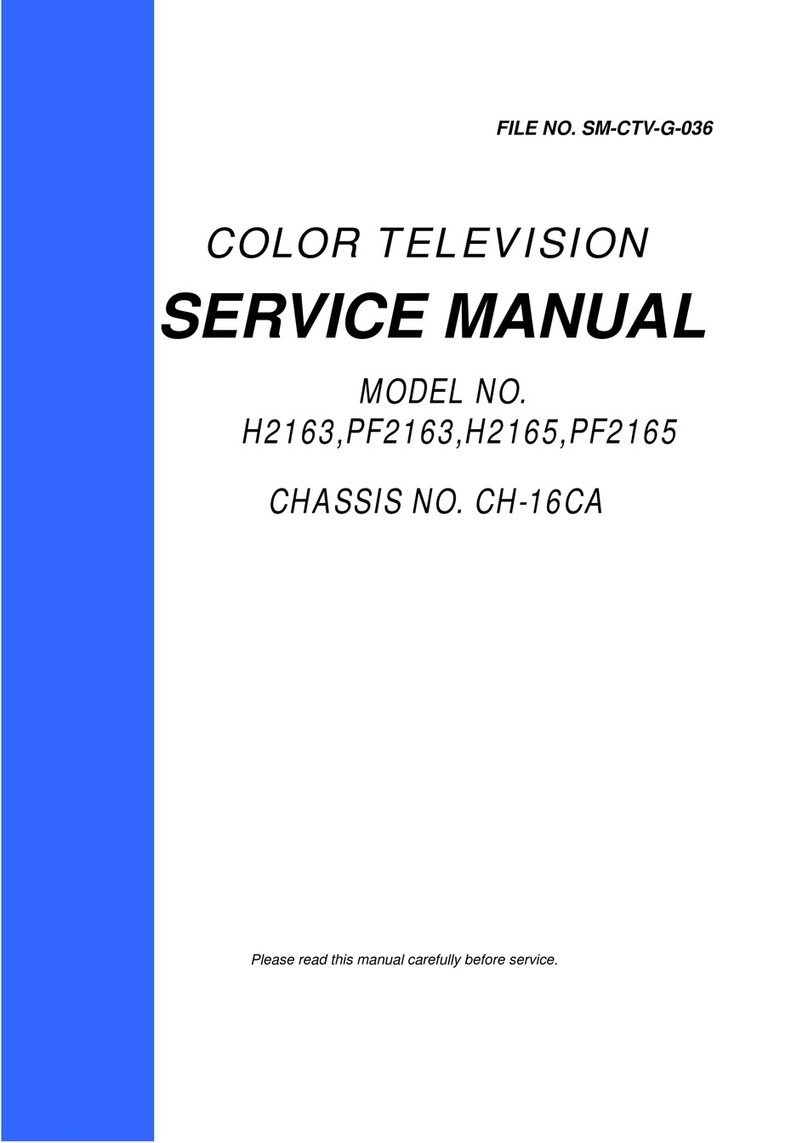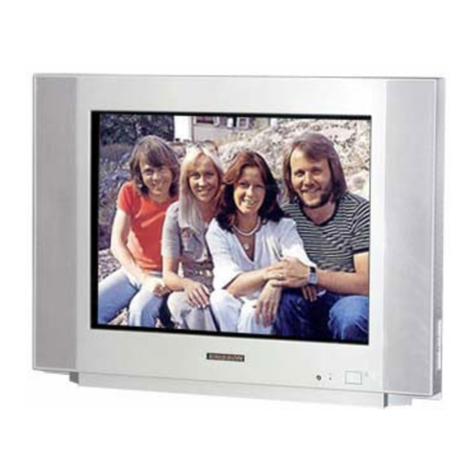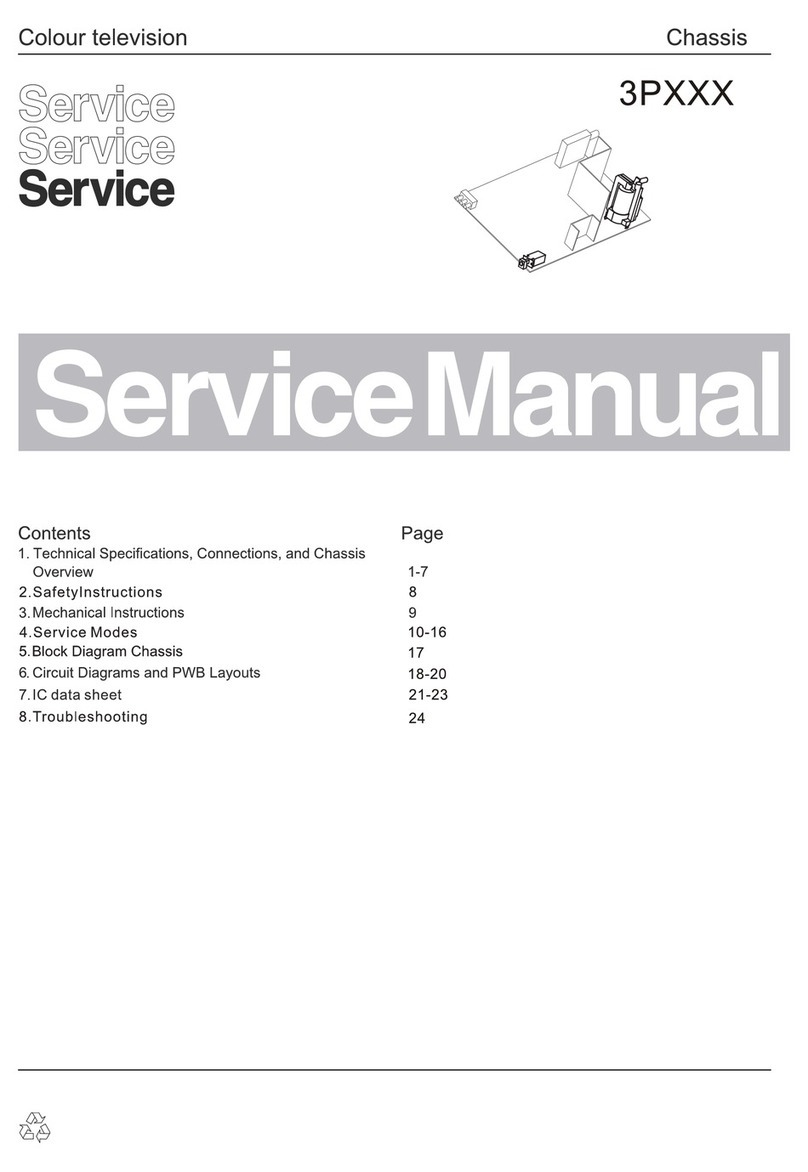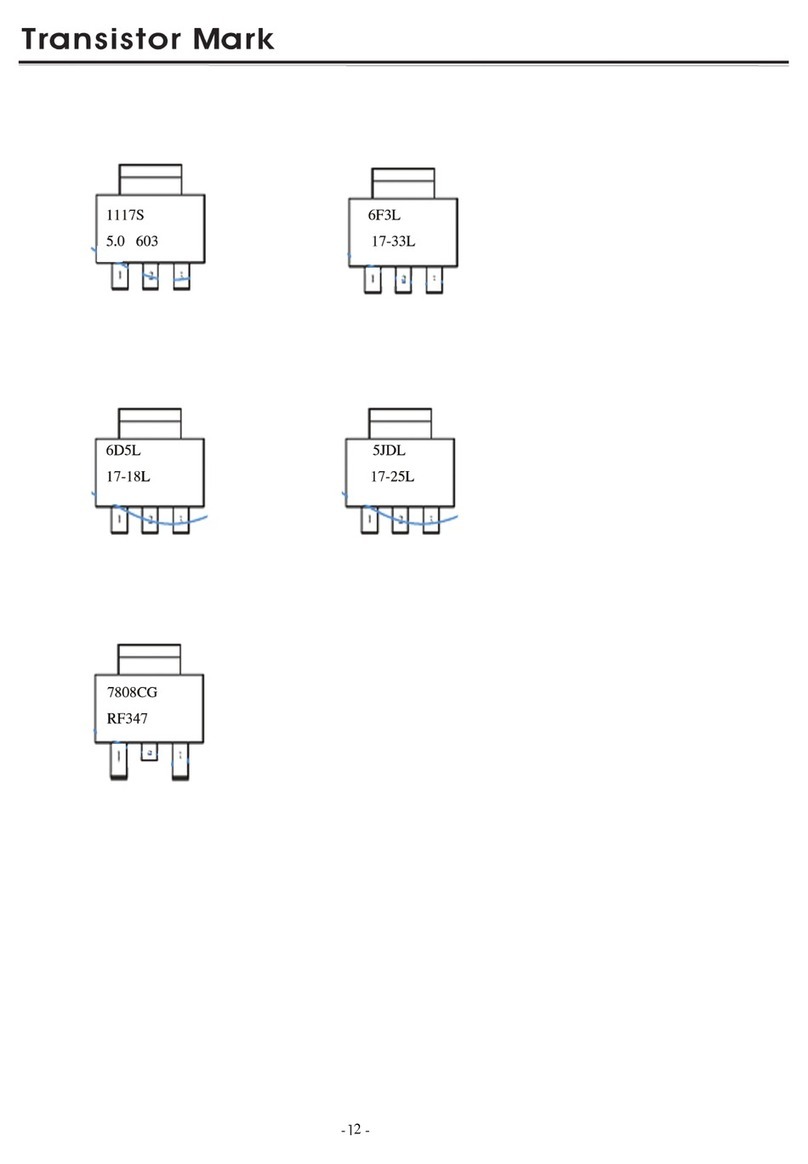ERISSON 2515 User manual

1
PRECAUTIONS DURING SERVICING
1. In addition to safety, other parts and assemblies are
specified for conformance with such regulations as
those applying to spurious radiation. These must
also be replaced only with specified replacements.
Examples: RF converters, tuner units, antenna
selection switches, RF cables, noise-blocking
capacitors, noise-blocking filters, etc.
2. Use specified internal Wiring. Note especially:
1) Wires covered with PVC tubing
2) Double insulated wires
3) High voltage leads
3. Use specified insulating materials for hazardous
live parts. Note especially:
1) Insulating Tape
2) PVC tubing
3) Spacers (insulating barriers)
4) Insulating sheets for transistors
5) Plastic screws for fixing micro switches
4. When replacing AC primary side components
(transformers, power cords, noise blocking
capacitors, etc.), wrap ends of wires securely about
the terminals before soldering.
5. Make sure that wires do not contact heat generating
parts (heat sinks, oxide metal film resistors, fusible
resistors, etc.)
6. Check if replaced wires do not contact sharply edged
or pointed parts.
7. Make sure that foreign objects (screws, solder
droplets, etc.) do not remain inside the set.
MAKE YOUR CONTRIBUTION TO
PROTECT THE ENVIRONMENT
Used batteries with the ISO symbol
for recycling as well as small
accumulators (rechargeable batteries), mini-batteries
(cells) and starter batteries should not be thrown
into the garbage can.
Please leave them at an appropriate depot.
I. Safety Instructions
WARNING:
Before servicing this TV receiver, read the X-RAY
RADIATION PRECAUTION, SAFETY INSTRUCTION
and PRODUCT SAFETY NOTICE.
X-RAY RADIATION PRECAUTION
1. Excessively high can produce potentially hazardous
X-RAY RADIATION. To avoid such hazards, the high
voltage must not exceed the specified limit. The
normal value of the high voltage of this TV receiver
is 27 KV at zero bean current (minimum brightness).
The high voltage must not exceed 30 KV under any
circumstances. Each time when a receiver requires
servicing, the high voltage should be checked. The
reading of the high voltage is recommended to be
recorded as a part of the service record, It is
important to use an accurate and reliable high
voltage meter.
2. The only source of X-RAY RADIATION in this TV
receiver is the picture tube. For continued X-RAY
RADIATION protection, the replacement tube must
be exactly the same type as specified in the parts
list.
3. Some parts in this TV receiver have special safety
related characteristics for X-RADIATION protection.
For continued safety, the parts replacement should
be under taken only after referring the PRODUCT
SAFETY NOTICE.
SAFETY INSTRUCTION
The service should not be attempted by anyone
unfamiliar with the necessary instructions on this TV
receiver. The following are the necessary instructions
to be observed before servicing.
1. An isolation transformer should be connected in the
power line between the receiver and the AC line
when a service is performed on the primary of the
converter transformer of the set.
2. Comply with all caution and safety related provided
on the back of the cabinet, inside the cabinet, on the
chassis or picture tube.
The lightning flash with arrowhead symbol,
within an equilateral triangle, is intended to alert
the user to the presence of uninsulated “dangerous
voltage” within the product’s enclosure that may
be of sufficient magnitude to constitute a risk of
electric shock to persons.
The exclamation point within an equilateral
triangle is intended to alert the user to the
presence of important operating and mainte-
nance (servicing) instructions in the literature ac-
companying the appliance.
CAUTION: TO REDUCE THE RISK OF ELECTRIC
SHOCK, DO NOT REMOVE COVER (OR BACK). NO
USER-SERVICEABLE PARTS INSIDE. REFER
SERVICING TO QUALIFIED SERVICE PERSONNEL
ONLY.
CAUTION
RISK OF ELECTRIC SHOCK
DO NOT OPEN

2
PRODUCT SAFETY NOTICE
Many electrical and mechanical parts in this TV
receiver have special safety-related characteristics.
These characteristics are offer passed unnoticed by
visual spection and the protection afforded by them
cannot necessarily be obtained by using replacement
components rates for a higher voltage, wattage, etc.
The replacement parts which have these special
safety characteristics are identified by marks on
the schematic diagram and on the parts list.
Before replacing any of these components, read the
parts list in this manual carefully. The use of
substitute replacement parts which do not have the
same safety characteristics as specified in the parts
list may create shock, fire, X-RAY RADIATION or
other hazards.
Good earth ground
such as the water
pipe, conductor,
etc.
Place this probe
on each ex-
posed metallic
part
AC VOLTMETER
AC Leakage Current Check
3. To avoid a shock hazard, always discharge the
picture tube's anode to the chassis ground before
removing the anode cap.
4. Completely discharge the high potential voltage of
the picture tube before handling. The picture tube is
a vacuum and if broken, the glass will explode.
5. When replacing a MAIN PCB in the cabinet, always
be certain that all protective are installed properly
such as control knobs, adjustment covers or shields,
barriers, isolation resistor networks etc.
6. When servicing is required, observe the original lead
dressing. Extra precaution should be given to assure
correct lead dressing in the high voltage area.
7. Keep wires away from high voltage or high tempera
ture components.
8. Before returning the set to the customer, always
perform an AC leakage current check on the exposed
metallic parts of the cabinet, such as antennas,
terminals, screwheads, metal overlay, control shafts,
etc., to be sure the set is safe to operate without
danger of electrical shock. Plug the AC line cord
directly to the AC outlet (do not use a line isolation
transformer during this check). Use an AC voltmeter
having 5K ohms volt sensitivity or more in the
following manner.
Connect a 1.5K ohm 10 watt resistor paralleled by a
0.15µF AC type capacitor, between a good earth
ground (water pipe, conductor etc.,) and the exposed
metallic parts, one at a time.
Measure the AC voltage across the combination of
the 1.5K ohm resistor and 0.15 uF capacitor. Reverse
the AC plug at the AC outlet and repeat the AC
voltage measurements for each exposed metallic
part.
The measured voltage must not exceed 0.3V RMS.
This corresponds to 0.5mA AC. Any value exceeding
this limit constitutes a potential shock hazard and
must be corrected immediately.
The resistance measurement should be done
between accessible exposed metal parts and power
cord plug prongs with the power switch "ON". The
resistance should be more than 6M ohms.

3
II. Specifications
1.Power supply TV: AC 220Vrms, 50Hz
Remote control battery: 3V (UM-3X2)
2.TV system RF input : PAL BG/DK, SECAM BG/DK
Video input: PAL/SECAM/NTSC 3.58/NTSC 4.43
3.Receiving channels VHF-L : E2-S10
VHF-H : E5-S41
UHF : E21-E69
4.Intermediate frequencies Picture: 38.9MHz
5.Scanning Horizontal (Hz): 15625/15750
Vertical (Hz) : 50/60
6.Color picture tube: 25” 29” 34” 110 degree north(1) hemisphere Bv=+0.35G±0.2G
7.Operating temperature Fulfil all specifications: 15°C ~ 35°C
Accept picture/tone reproduction: 5°C ~ 45°C
8.Operating relative humidity Fulfil all specifications: 45% ~ 75%
Accept picture/tone reproduction: 15% ~ 90%
9.Electrical & Optical Specification:
No. Items Instruction Typical Limit Unit
1 Video sensitivity For 30dB S/N 45 ≤51 dBuV
2 FM sound sensitivity For 30dB S/N 28 ≤35 dBuV
3 Synchronizing sensitivity For RF transmission 25 ≤30 dBuV
4 Color sensitivity For RF transmission 32 ≤40 dBuV
5 Teletext sensitivity TV screen refreshes 40 times
number of mistakes ≤8 N/A N/A dBu
6 Minimum NICAM threshold Without crackline noise N/A N/A dBu
7 AGC static characteristic Accept. Picture/tone repr. 103 ≥100 dBu
8 Selectivity Adjacent sound carrier 40 ≥35
Below adjacent sound carrier 35 ≥30 dB
Adjacent picture carrier 50 ≥40
Up adjacent picture carrier 45 ≥30
9 IF rejection 55 ≥50 dB
10 Image rejection VHF 55 ≥50 dB
UHF 50 ≥45
11 AFT pull-in range M/N N/A N/A MHz
DK/I/BG ±1.5 ≥|±1.0|
12 Chroma sync pull-in range ±500 ≥|±200| Hz
13 Color killer function -25 ≤-16 dB
14 DC restoration 3 ≤10 %
15 Resolution Horizontal PAL/SECAM 320 ≥300
NTSC 270 ≥250
Vertical PAL/SECAM 410 ≥400 lines
NTSC 320 ≥300
16 Overscan Cross hatch signal 93 90~96 %
17 Linearity Horizontal 7 ≤10 %
Vertical 6 ≤8%
18 Pattern distortion 1.5 ≤3%
19 Picture position In all direction ±3 ≤|±6| mm
20 Raster rotation In all direction 4 ≤6mm
21 Convergence error 0.4 ≤0.6 %
22 White balance (8700°K) X 0.288 0.288±0.015
Y 0.298 0.298±0.015 /
23 Maximum full white At picture tube center 80 ≥60 cd/m2 For 29” 34”
90 ≥80 cd/m2 For 25”
24 H sync pull-in range ±500 ≥|±200| Hz
25 V sync pull-in range 7 ≥6Hz
26 Anode voltage 29 ≤32.5 KV For 29” 34”
27.5 ≤30 KV For 25”
27 Audio frequence response ±3dB ref. to 1KHz 0.2~10 0.2~10 KHz
28 Audio output power 1KHz 10% THD 2x7.5 ≥2x7.5 W For 34”
50KHz DEV. (BG/I/DK) 2x5 ≥2x5 W For 25” 29”
25KHz DEV. (M/N)

4
No. Items Instruction Typical Limit Unit
29 THD Po=0.5W 1KHz 1 ≤3%
30 Signal to buzz ratio 42 ≥40 dB
31 Minimum volume hum 6 ≤10 mVrms
32 Maximum woofer output power N/A N/A W
33 Woofer audio freqency response ±3dB ref. to 80Hz AV mode N/A N/A Hz
34 Bass control range 100Hz ref. to 1KHz AV mode N/A N/A dB
35 Treble control range 10KHz ref. to 1KHz AV mode N/A N/A dB
36 Balance Center N/A N/A
Max. N/A N/A dB
Min. N/A N/A
37 Volume control curve Kawa A /
38 Video input level 1.0 1±0.2 Vpp
39 Audio input level 0.5 0.5±0.3 Vrms
40 Video output level 1.0 1±0.2 Vpp
41 Audio output level 0.5 0.5±0.3 Vrms
42 Power consumpution Operating 180 ≤200 W For 34”
110 ≤150 W For 25”
120 ≤160 W For 29”
Stand by 10 ≤15 W
43 IR receiving distance ±30° 6 ≥4m
44 X-ray radiation <0.1 ≤0.5 mR/h
45 Dielectric strength AC 3KVrms 2 sec. 3 ≤5 mArms
W
H
1/9H
1/9W
+P8 P5+
+P7 P6+
+P1
+P3
+P4 P2++P0
Test Condition
1 Picture Modulation 87.5%
2 Sound Modulation 27KHz Dev. For DK/I/BG
15KHz Dev. For M/N
3 Picture to Sound Ration 10dB
4 Sound Artificial Load Resistor 8 ohm
5 Video signal White and black
(three white & two black)
6 Audio signal 1KHz sine wave 0.5Wrms Convergence error test point on
7 Conditions of the TV setting:screen
A. Switch TV on and let it warm up for more than 30 minutes.
B. Connect RMS volt meter to speaker terminals and adjust theTV volume to get 500mW RMS power at each terminal.
C. Place the MINOLTA CA-100 test probe to white part of the screen,adjust the contrast until a reading of 80cd/m2
is obtained.
D. Place the MINOLTA CA-100 test probe to black part of the screen,adjust the brightness until a reading of 2cd/m2
is obtained.
E. Repeat step C & D until the exact luminance values is obtained or the nearest possible values you can get.then
record the luminance values & R.G.B gun voltage values at the same time. and take the largest values for
measurement referenct.
F. Input standard color bar(100/0/75/0),then adjust the colour.until the waveforms at the blue gun of same level
is obtained.

5
No. Designation Requirement Reference Model Remark
1 Pattern Generator System of output signal: PHILIPS
RF out: PAL BG/SUB/DK/I, PM5518-TN
SECAM B/G/D/K, NTSC M PM5418-TN
Video out: NTSC 4.43/3.58 PAL 60Hz
2 Digital voltmeter Input Resistance 10M FLUKE 45
3 Withstanding Withstanding Voltage: KIKUSUI TOS 8650 Irresistible Voltage Measure
Voltage Tester AC 1.5KV, 5KV/0-5KV ± 3%
Cut-off current: AC 0-2mA,
20mA / continuously Adjustable
4 Insulation Tester Test voltage:1000V. 500V KIKUSUI TOS 7100L
5 Sine wave Signal Frequency Range: 0.1~140MHz LEADER 3216 For generating IF Signal
Generator ( Precision:10KHz )
Level Range: -20~126dB
6 Oscilloscope Frequency response: 20MHz or above
7 CRT Color MINOLTA CA-100 For White Balance Adjustment
Analyzer
8 DC Regulated Max output Voltage 14V Supply DC power
Power Supply
9 Color Monitor AV receiving system: Should include Same model (of TV set) For operation check
all the AV output system of the as the products For resolution check
products at least. For Skew Check
10 Audio Signal Frequency of output signal: KENWOOD AG-203A For generating audio signal
Generator 20Hz-20kHz
III. Level List of Equipments & Instruments Required for Production
IV. Applying Adhesive on Main PCB
Note: The ref. No. from 1 to 10 should be applied one Diabond 1603HFR Ivony Adhesive for each.
Table of contents
Other ERISSON TV manuals























